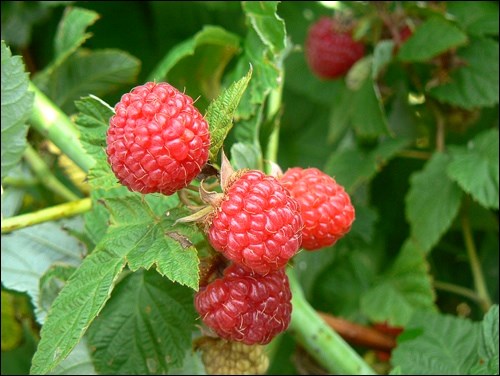Pleny the Elder, a Roman scholar, wrote about raspberries in the first century AD and they have been a well-loved soft fruit ever since. European raspberry selections arrived with early settlers and joined the wild ones found throughout the prairies. While most of our older raspberries were simply selections made from native stands or European varieties, modern raspberries include genetic material from both the Old and New World.
Biology
Raspberries have a fibrous, long-lived perennial root system. These roots are fairly shallow with over 70 per cent found in the upper 25 centimetres of soil. They don’t tolerate poor drainage or excessive cultivation.
Suckers are usually initiated in the fall, when they grow only to the soil surface. Additional above-ground growth of the suckers occurs the following spring.
There are two types of canes. Vigorous, more productive ones are produced from the crown at the base of the plant and should be kept. Smaller, less productive canes, produced randomly from the roots (further from the established row), should be removed.
Most raspberries have a biennial growth habit. First year (“primocane”) growth is rapid and vegetative (leafy), taking place in spring and early summer. These canes are mostly unbranched.
During their second year, these canes (now called “floricanes”) flower and fruit. Buds in the middle portion of the cane are the most fruitful. Canes do not increase in height during their second year, and after fruiting, they die. At the same time, new canes are being produced to replace them for the coming season.
Raspberry flowers have both male and female parts and are self-fruitful. Two cultivars are not needed to set fruit. Flowering occurs over a four-week period and bees are the main pollinators. Avoid using insecticides.
Fruit takes 30 to 45 days to develop, depending on the cultivar and weather conditions. Since the greatest increase in fresh weight occurs in the final seven to 10 days of fruit development, watering at this time is beneficial.
Cultivars
The following are a few of the cultivars that have been developed specifically for prairie conditions. Other varieties are worth trying, but start with just a few to see if they will grow well for you in your location.
Boyne is one of the older but most frequently grown raspberries on the prairies. Developed at the Morden Agricultural Canada Research Station in Manitoba, it is hardy and consistently productive. Canes are medium height, thick, erect and stocky, with many lateral branches. Boyne suckers freely. Fruit is medium-sized (16.3 millimetres in diameter), dark red, juicy, aromatic and tart. It is very good fresh or frozen and excellent for processing.
Red Mammoth, from the University of Saskatchewan (1999), has firm juicy, bright red berries that are easily picked and produced over a long period. The fruit is larger (21.5 millimetres in diameter) than Boyne, sweeter, and higher yielding. It has good vigour and is hardier than Boyne. The drawback: canes are less sturdy and require support through trellising.
Steadfast, another University of Saskatchewan selection, has very little suckering, making it ideal for smaller urban gardens. The fruit quality is similar to Boyne. The round, bright red berries are easily detached, produce over a longer season, but are lower yielding. Cane sturdiness is similar to Boyne.
Red Bounty, also from the University of Saskatchewan (1999), has large (19.9 millimetre), flavourful, round bright red fruit that is excellent for processing and easily detached for picking. Hardier than Boyne, the canes are of medium stature, but less sturdy and require support;
Honey Queen, developed by Robert Erskine of Rocky Mountain House, Alta., many years ago, is a sweet, golden yellow berry with a unique taste, excellent for fresh eating and with ice cream. It does not freeze well but is said to make excellent wine.
Fall-bearing raspberries such as Autumn Bliss produce fruit late in their first season. Worthy of trial in a protected location if space permits, they are generally not reliable unless our growing season is prolonged without near or below-freezing temperatures.
Sara Williams is the author of the newly expanded and revised Creating the Prairie Xeriscape; Gardening, Naturally: A chemical-free handbook for the Prairies; and the Saskatoon Forestry Farm Park & Zoo: A Photographic History. Sara will be leading a garden tour to Great Britain in May 2016 and co-leading, with Melanie Elliot, a tour of Fauna and Flora of Iceland in July 2016. Call Ruth (1-888-778-2378) for more information.
GardenLine is open for the season to solve your garden problems: 306-966-5865; gardenline@usask.ca
— This column is provided courtesy of the Saskatchewan Perennial Society (www.saskperennial.ca; hortscene@yahoo.com). Check out our Bulletin Board or Calendar for upcoming garden information sessions, workshops and tours: Provincial Horticultural Show in Sturgis (Aug. 13, www.icangarden.ca/clubs/SHA); Prairie Water Gardening Society pond tour (Aug 16., www.prairiewatergarden.ca/).



